Abstract
The last decade has witnessed growth in secular lifestyles in Western countries that has gained the attention of the prophet and the apostles. Never has the gulf in moral values between Western society and the LDS Church been so wide, and as that gulf has widened, Church growth has slowed. Secularism is not the only trend of concern; declining fertility rates are as well. There is considerable variation between countries in terms of Church growth. Institutions that have evolved over centuries may explain that variation. Using data on Church growth, retention of members, institutions, fertility and secularism, I find statistical support for this institutional theory. Inclusive institutions are associated with economic growth, declining fertility and higher levels of secularism. The Church grows slowly in these countries, but retention is higher. Extractive institutions display the opposite tradeoff. Countries with extractive institutions experience slow economic growth, high rates of fertility and rapid Church growth, but low retention. The predictable relationship between the quality of institutions, Church growth and retention creates an opportunity to use the talents and resources of members living in countries with inclusive institutions to cultivate faith in countries with extractive institutions. It also leaves the Church with twin challenges: how can it increase growth in countries with inclusive institutions and foster retention in countries with extractive institutions?
*
A Conflict of Moral Visions
In an October 2011 conference address, President Thomas S. Monson reflected, “I recall a time—and some of you here tonight will also—when the standards of most people were very similar to our standards. No longer is this true.” He went on to describe a New York Times article summarizing a study conducted by a sociologist, in which 230 American young adults were asked open-ended questions about right and wrong. The study concluded that most young people had “not been given the resources—by schools, institutions [or] families—to cultivate their moral intuitions.” President Monson dared members to stand alone, if necessary, living and sharing the gospel.
Though President Monson did not elaborate on the societal consequences of youth without moral direction, others in the general leadership have. At the April 2013 General Conference, Elder L. Tom Perry warned, “Today we find ourselves in another war. This is not a war of armaments. It is a war of thoughts, words, and deeds. It is a war with sin, and more than ever we need to be reminded of the commandments. Secularism [1] is becoming the norm, and many of its beliefs and practices are in direct conflict with those that were instituted by the Lord Himself for the benefit of His children.”
Six months after Elder Perry’s talk, Elder Dallin H. Oaks observed several “concerning trends,” including a decline in marriage, growth in single-parent households and, most important for the purposes of this paper, falling birth rates. He observed, “The United States now has the lowest birthrate in its history, and in many European Union nations and other developed countries, birthrates are below the level necessary to maintain their populations. This threatens the survival of cultures and even of nations.” He exhorted listeners not to “set our hearts so much on the things of the world and aspire to the honors of men (D&C 121:35) that we stop trying to achieve our eternal destiny.”
The LDS Church leadership would not be concerned with rising secularism and falling birth rates if they did not affect its mission, to bring souls unto Christ. No statistic this side of the veil is sufficient to measure that mission, but they may be sufficient to measure patterns and trends. Growth in membership can easily be calculated using data reported in Church Almanacs and despite this statistic’s inability to measure the intensity of a new member’s conversion, it does show a trend. The Church continues to grow, but growth has slowed, as has the increase in missionaries serving (at least until President Monson’s announced the lowering of the missionary age requirement in October 2012). Figure 1 compares the rate of growth of Church membership and missionaries set apart from 1956 to 2011. Two events still clearly show in the data. In July 1960, the Church lowered the age requirement for young men to 19 from 20 years-old and for young women, from 23 to 21. However, as the Vietnam War deepened and the draft accelerated, the Church negotiated a quota system with the Selective Service to protect the missionary program. The quota dramatically slowed the growth rate of missionaries set apart, but the decrease was smaller than during the Korean War (Dew 1996). In 1969, as the war was winding down and a lottery system modified the draft, the growth rate of missionary numbers resumed a trend of slow decline, peaking in 1961 at 18.97 percent before falling to -.20 percent in 2011. Church growth peaked at 5.86 percent in 1965 and has fallen to 2.40 percent in 2011.
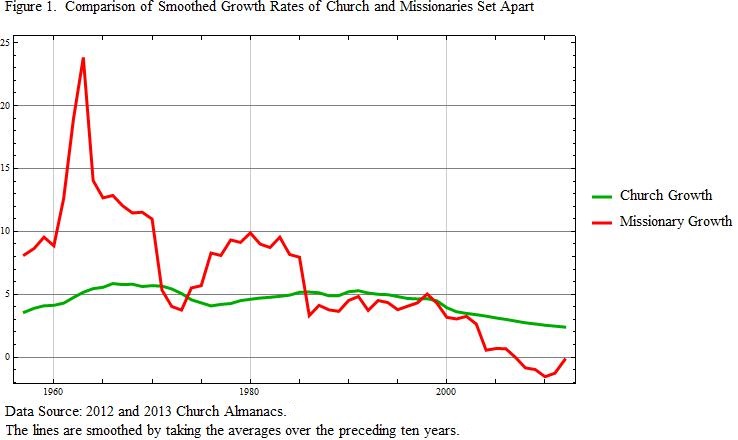
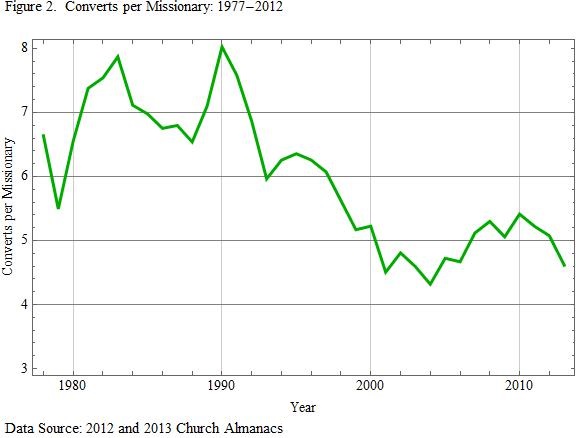
Trends of Consequence
1) A Legacy of Institutions and the Allocation of Wealth
Adam Smith believed that it is part of human nature to "truck, barter, and exchange one thing for another,” but the efforts of economic agents have met different degrees of success in creating wealth for themselves and the countries in which they live (Smith 1905, I.2.1). Figure 3 shows the distribution of average income (per capital Gross Domestic Product measured at purchasing power parity) in 2011 around the world. The darker the green, the poorer the country, and the brighter the yellow, the richer. Countries without data are white. This distribution is well known, but the underlying causes of the variation have been less clear.
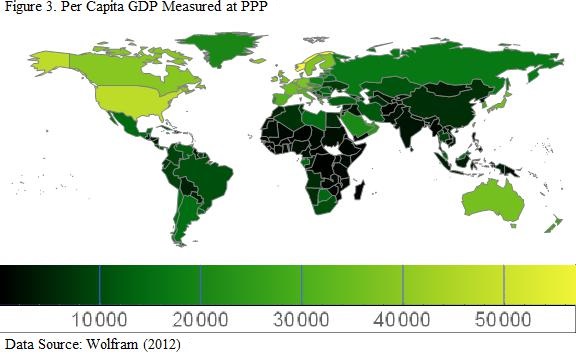
In the long-run, political institutions tend to be either primarily extractive or inclusive. If the elite in a country control extractive political institutions but economic institutions are inclusive, they will alter the economic institutions for their benefit. Likewise, if both political and economic are inclusive, broad coalitions of voters tend to protect inclusive economic institutions. Perhaps the likelihood of social conflict is greatest when the elite control extractive economic institutions but the political institutions are inclusive. The elite will attempt to alter the political institutions to meet their needs--or a wide segment of the population, acting through the inclusive political institutions, will attempt to make the extractive economic institutions more inclusive (Acemoglu and Robinson 2012).
Acemoglu and Robinson (2012) theorize that small differences at critical junctures expose political and economic institutions to evolution that Joseph Schumpeter described as “creative destruction.” However, there are two important corollaries to their theory. First, institutions do not necessarily evolve in a positive direction, and second, entrenched elites don’t like creative destruction and, as a rule, are successful in maintaining extractive institutions. Their success in maintaining extractive institutions is called the iron law of oligarchy (Acemoglu and Robinson 2012).
Acemoglu and Robinson (2012) illustrate this general theory and the two corollaries with one example. In 1346, the Bubonic plague brought a critical juncture to feudal Europe. The plague decreased the labor supply and increased agricultural wages. Governments throughout Europe tried to suppress wages first by edict and then by force. But there was a small difference between Western and Eastern Europe—a slightly greater number of small towns in the west offered serfs opportunities outside of the feudal manor. The alternatives available to the serfs off the feudal manor in the west gave them an edge through the process of creative destruction, and they were able to establish more inclusive institutions. In the east, however, demand for agricultural goods was rising and serfs had fewer opportunities in cities. Feudal lords suppressed wages, forced compliance and established more extractive institutions characterized by expanded feudal holdings, resulting in a period known as the second serfdom. Clearly, institutions don’t always evolve toward inclusion.
Europe’s Atlantic trading countries colonized much of the world, but the institutions they established in their colonies depended on two factors: the wealth of the colony available for plunder, and the ease of conquest and settlement. Wealthy lands with inhospitable environments were controlled with extractive institutions. Targets like the Atlantic Coast colonies with little wealth but hospitable environments drew European immigrants who brought inclusive institutions. This pattern of colonization brought a “reversal of fortunes” to previously poor areas—now the United States, Canada, Australia and New Zealand—and also to previously wealthy areas such as India, the Aztec and Incan Empires (Acemoglu, Johnson and Robinson 2002). As implied by the iron law of oligarchy, elite leaders in nations with extractive institutions actively attempt to block institutional change that they believe might challenge their political and economic domination.
Acemoglu, Johnson, and Robinson (2001) provide empirical evidence that the institutions that European colonizers imposed upon their colonies largely explain the institutions that govern these countries today and the level of wealth of the governed. They collected sample data from 64 countries that at one point were European colonies. The data for each country included the average income, institutional quality, and mortality rate of European settlers. Using a statistical technique called two-stage least squares regression, they were able to demonstrate that the mortality rate was a significant determinant of current institutional quality (first-stage), and that institutional quality was a significant determinant of average income (second-stage).
Figure 4 uses the Composite Risk Rating for 2012 produced by Political Risk Services as a proxy for how inclusive or extractive the political and economic institutions are within a country. It assigns countries scores from 0 to 100, with low scores indicating that a country is perceived as corrupt and high scores, clean. By extension, countries with the low scores have the most extractive institutions and those with high scores, the most inclusive. On the map, low scores are represented by a dark green. As the score improves, the dark green grows lighter, eventually turning yellow. Countries without scores are represented with white.
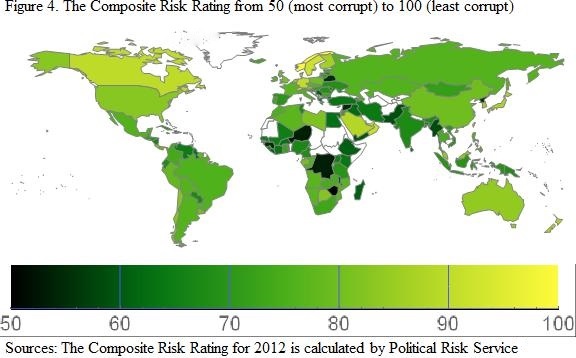
2) Rising Income and the Total Fertility Rate
Becker’s (1960) economic theory of fertility provides a solid foundation for discussing determinants of fertility across the spectrum from extractive to inclusive institutions. In the realm of the economist, children are a durable consumption good or, if they bring income into the home, a production good. Factors that add to the cost of raising a child tend to decrease fertility and those that decrease the cost, tend to increase fertility.
If children are production goods, the value of an additional child rises with the probability that he or she adds to family income. If they are consumption goods and the cost of raising children does not change, the value of an additional child increases as income rises. Over the past two hundred years, people in countries with inclusive institutions have experienced rapid change in economic conditions. Employment in agriculture has declined while industry has increased, and children were barred from labor markets, placing downward pressure on fertility. On the other hand, people living under extractive institutions have gained less, and children are more likely to be considered production goods. Over the same time frame, incomes have soared in countries with inclusive institutions while they have only inched forward in countries with extractive institutions. Increasing income tends to increase fertility if other variables remain unchanged, but they have not.
Children are produced at home under uncertainty. Parents who desire three children might only have one, and others that want two might produce six. Couples who wanted sons might have daughters. Prior to affordable and reliable pharmaceutical methods of birth control, cultural norms for marriage, nursing and infanticide (mostly of female babies), determined fertility (Hudson and den Boer 2012). The average fertility of women in countries with little knowledge of or access to contraception is high. For example, in the nineteenth-century, women in Ireland had about eight babies each (Becker 1960); biology and environmental scarcity, stress and access had more to do with fertility than secularism or natalism.
The advent of the birth control pill in 1960 provided a cheap, effective method of controlling fertility. Innovation typically comes first to countries with inclusive institutions, and the pill followed the general rule. With it, women in countries with inclusive institutions reduced the number of children they produced toward the number they desired. In addition, in countries with inclusive institutions—implying good medicine—women have fewer children because the declining probability of death or disability of a child also reduces fertility. In contrast, elite suppression of innovation and income through extractive institutions implies that medicine in extractively-inclined countries will be more expensive and of lower quality, the introduction of affordable birth control will be slower, and knowledge of and access to its use will be lower.
Another factor affecting fertility involved the trade-off between quantity of and investment in children. The consumption of goods, including children, can increase in quality as well and quantity. If someone wants to consume more cars, he can buy one or trade for another with more desirable features. Similarly, if a woman wants more children, she can improve the quality, the quantity or both. Becker, Murphy and Tamura (1990) use a generational model that finds that when rates of return are high (low) on education relative to the rate of return on the number of children, women tend to have fewer (more) children and invest more (less) in their education. Countries with inclusive institutions generally have higher returns on education than countries with extractive, and this may also depress fertility.
Rearing children requires time as well as money, and in countries with inclusive institutions, the sacrifice of foregone wages is greater. Last (2013) observes that between 1985 and 2012, fathers doubled the time they spent with their kids and working mothers today spend more time with her children than a typical mother in 1965. He also examines the cost trends of having a baby in the United States between 1960 and 2011. As an example of the high cost of parenthood, the United States Department of Agriculture (USDA) estimated the real cost to raise a child from birth until their 18th birthday increased 15 percent between 1960 and 2007 (Last 2013). The estimates do not take into account child care, college tuition or the mothers’ foregone income. These costs have increased over time: more women have entered the labor-force, their real wages have increased, and college costs have soared well above the rate of inflation. Ignoring child care and opportunity costs, the cost of earning a college degree in 2011 at a state-run college or university adds another $145,000 to the parents’ cost of raising a child to adulthood. Thus, as the cost of raising a child increases, the number of children tends to decrease.
Figures 5 and 6 show the total fertility rate by country for 1960, the year that the birth control pill came to market, and then in 2011. They give a quick visual impression of declining fertility. Countries with high fertility are dark green, those with low fertility are bright yellow, and countries with missing data are white. High income countries have lower fertility than low income countries, and virtually all countries have lower fertility now than in 1960. Table 1 lists the average fertility for nations with inclusive and extractive institutions by decade beginning in 1960. Extractive institution-based societies are further divided into communist or other. Figures 5 and 6 visually display the global fall in fertility.
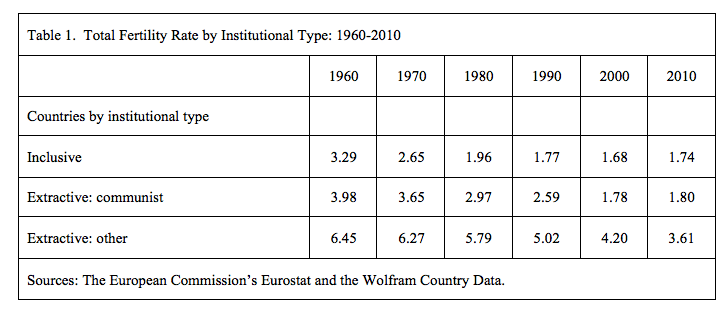
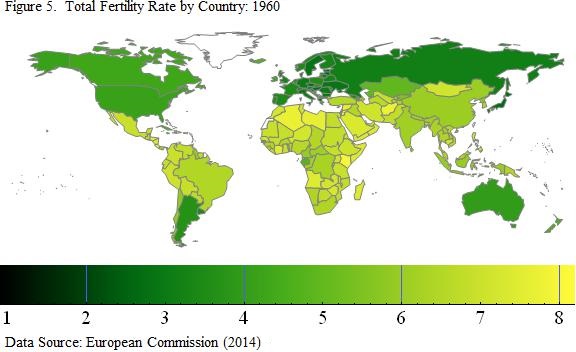
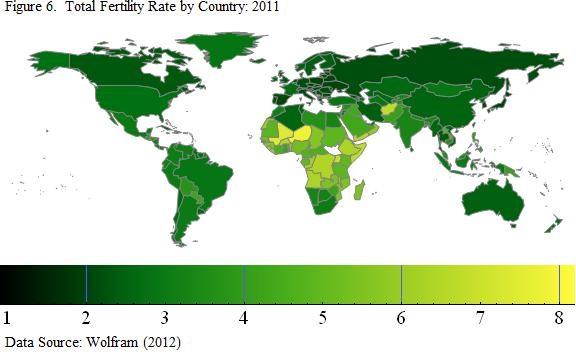
The fertility in nations with other types of extractive institutions has also fallen. In part, extractive institutions are maintained by slowing change, implying that birth control methods would slowly be integrated into family life. In 1960, these nations had an average fertility of 6.45. By 1970, it had fallen only 2.88% to 6.27. Compare this contraction to the 19.88% contraction in the fertility in nations with inclusive institutions. After the initial decade, the fertility fell steadily: 13.37%, 16.27%, and 13.97% over the following decades. Overall, fertility has fallen 44.02% to 3.61, and seems poised to fall more.
3) Secularism and Dissent
Dissent is not new to religious organizations, but does its nature change depending on the presence of divine authority or the nature of political and economic institutions? In this section, I present a review of a limited number of historical events when dissent flourished to give context to the current spiritual environment. The section is divided into three parts. In the first, I review examples from the Book of Mormon in which dissent signified direct opposition to the Church of Jesus Christ during periods when the state governed with extractive institutions. Next, I review dissent from the church that Jesus established in the Old World during His ministry after the apostasy deprived it of His authority. Depending on historical context, I refer to it as the state church, Catholic Church or traditional Christianity. Finally, I evaluate dissent under inclusive rather than extractive political and economic institutions. All data sources are described in the Appendix.
Dissent from the Church of Jesus Christ
In the examples presented from the Book of Mormon, dissent is direct opposition to the Church of God or represents adherence to beliefs that deny God, His active intervention through individual lives or prophets, or the importance of following His commandments. Jacob writes of a behavioral apostasy caused by a successful “search for gold, and for silver, and for all manner of precious ores” (Jacob 2). Some found riches, and from riches arose pride, unrighteous persecution of the poor and unchaste practices. Sherem, an educated man, suggesting he was of the social and economic elite, attempted to organize the disaffected in response to Jacob’s call for them to repent. Sherem taught that that there was no prophecy and there would be no Savior. His protest ended with his death after he was struck down by God and confessed that he had been deceived by the devil (Jacob 7).
In another case, Nehor introduced priestcraft into Nephite culture, successfully starting a church that taught a feel-good doctrine that “all mankind should be saved at the last day, and that they need not fear nor tremble, but that they might lift up their heads and rejoice; for the Lord had created all men, and had also redeemed all men; and, in the end, all men should have eternal life” (Alma 1:12). Nehor suffered an early death, but his church continued to grow, straying from the moral teachings of the gospel and committing all manner of wickedness (Alma 1: 32). The Church also prospered, though, and more than that of Nehor. Members continued to live the gospel and were generous to the poor (Alma 1: 25-31).
Later in the Book of Mormon we read of Korihor, an anti-Christ who taught the people not to believe “the prophecies which had been spoken by the prophets, concerning the coming of Christ” (Alma 30: 6). According to Korihor, every man fares “in this life according to the management of the creature; therefore every man prospered according to his genius, and that every man conquered according to his strength; and whatsoever a man did was no crime” (Alma 30: 17). He was a successful orator, “leading away many women, and also men, to commit whoredoms” (Alma 30:18).
Dissent from Traditional Christianity
The Church the Savior organized in the Americas became unrecognizable over time, and in the Old World it drifted from His organization. Three critical junctures involving the Christian Church impact both its institutional structure and that of governments in Europe. The first was the Emperor Constantine’s decision to protect and subsidize the church, making him its de facto leader. A resulting cost to the church was loss of independence from the state. The emperor influenced internal governance directly by making church law and through the appointment of high ranking ecclesiastical officials. (Fukuyama, 2011). One small institutional difference was the relative strength of the empire in the east, where the empire was organizationally strong, and the west, where it was organizationally fragmented. Over time, the influence of the state church strengthened in the west relative to the Emperor, but not in the east--setting up the second critical juncture.
Gregory VII (1079-1085), a reforming pope, declared the right to appoint ecclesiastical authorities and stressed the moral authority of the church over all Christians, including emperors and kings. His militant position was opposed by Holy Roman Emperor Henry the IV. Open conflict ended with Concordat of Worms in 1122 in which the parties to the agreement recognized the Catholic Church’s authority over spiritual matters and the appointment of ecclesiastical authorities, and the state’s authority over temporal matters (Fukuyama, 2011). The agreement marked the birth of the modern secular state in Europe, a state in which officials are appointed without approval of religious organizations.
The secular state, a state without a preference for one denomination over another, may have been a necessary condition for the restoration. The Catholic Church emerged as the only international organization in Western Europe that could morally challenge actions of the secular state. The elites who governed these secular states chaffed at the influence of the Catholic Church within their boundaries. The small difference during this period was political limitations on the secular monarchies within that state (Acemoglu, Johnson and Robinson, 2005). Absolutist monarchs had fewer governmental checks on their authority but were weaker in their ability to tax and mobilize resources within their countries. Absolutist monarchs cut deals with the Catholic Church, but non-absolutist monarchs cut out the Catholic Church by authorizing religious dissent (Fukuyama, 2011). Indeed, Hart (2009) asserts that the Reformation “flourished only where it served the interest of the secular state in its rebellion against the customs and laws of Christendom, and in its campaign against the autonomy of the [Catholic] church within its territories.”
I have reported three cyclical events from the Book of Mormon in which the dissenters lost, and also the drift of the Church of Jesus Christ in the Old World from its original organization. It is important to recall that because dissent caused apostasy in both the Old and New World, the authority of the Church was removed from the earth. Other than possibly the theocracies of Nephi, Mosiah, Benjamin and Mosiah (the son of Benjamin and grandson of Mosiah), the political and economic institutions described in the Book of Mormon, the New Testament, and also those that operated during Late Antiquity and the Middle Ages were extractive in nature. The temptation to use these institutions for personal or group aggrandizement was too great to allow the Church, the one enduring inclusive institution, to continue unless altered for the benefit of the elite to become extractive itself.
Dissent from Religious Organizations under Inclusive Institutions
In countries with inclusive institutions within a secular state, both the freedom to worship or abstain from it are likely to coexist because neither the religious nor the irreligious can use the coercive power of the state to impose their views on others. Dissenters from traditional views must compete against those ideas and the organizations that promulgate them in the market place of ideas, subjecting all to the forces of creative destruction. Joseph Smith, the prophet of the Restoration, dissented from traditional Christianity. The Church was restored in the United States, a country that provided an opportune and perhaps unique institutional setting. The government was secular; its leaders were not appointed with the approval of religious organizations. Its citizens were traditional Christians, suggesting that they would understand the significant differences between traditional Christianity and the restored Church. Its inchoate political and economic institutions were inclusive, even if they initially failed to protect the fledgling restored Church. The constitution of the United States guaranteed freedom of religion and its citizens were relatively tolerant of religious competition. The Church's first successful efforts to win foreign converts were in Great Britain and then in other European countries with state religions but strengthening inclusivity.
Inclusive institutions protect those who dissent from religion and while many argue that religion has lost ground to the irreligious in recent decades, or perhaps centuries, the cause of the loss is widely debated. I present two explanations given by others and offer a third for consideration. In a thought- provoking article which draws on the work of sociologists and philosophers, Dreher (2013) begins with a quote from Charles Taylor’s A Secular Age, “The entire ethical stance of moderns supposes and follows on from the death of God …” and continues, “To be modern is to believe in one’s individual desires as the locus of authority and self-definition.” To be modern is to be secular. Dreher (2013) describes how Christianity, which has dominated Western society for nearly two millennia, holds that God and his commandments, particularly in regards to sex, dictate that people restrict their behavior, not because it is good for them but because it is right and good for social order. However, beginning with the Enlightenment, secularism has made inroads against Christianity. The secularist views an individual’s desires as central to self-definition and eschews cultural limitations placed on human behavior. Christianity and secularism are polar opposites. Whereas the one seeks fulfillment by restraint from sin, the other finds it in expression of desires. Dreher’s analysis suggests an increasing acceptance of a secular lifestyle. In addition to formal dissent, people may be distracted from religion by wealth. The secularization hypothesis states that people become less religious (as measured by church attendance and religious beliefs) as countries become wealthier (Barro and McCleary, 2003). Finally, the rising secular lifestyle may be cyclical as was much of the dissent from the Church described in the Book of Mormon.
Whatever the cause, Elder Perry’s apostolic warning about increasingly secular lifestyles can be empirically documented. Funk and Smith (2011) report that over a five year period, people unaffiliated with any religion have increased from 15.3% in 2007 to 19.6% in 2012, with the largest increases coming from young people. Keysar (2007) reports that men in the United States, who compose 48% of the U.S. adult population, compose 56% of those claiming no religious affiliation. Additionally, in a July 27, 2012 press release, WIN-Gallup International released their “Global Index of Religiosity and Atheism,” reporting a 9% fall in religiosity and 3% increase in atheism worldwide since 2005, based on comparing the change in 39 countries between 2005 and 2009.
Results of Statistical Testing [2]
Does the mortality rate of European colonizers, as an indicator of inclusive versus extractive instituations, bear any relationship to LDS Church growth in those former colonies?
While the objective of Acemoglu and Johnson (2012) was to demonstrate that political and economic institutions that grew from small differences at critical junctures or that were imposed on a country through colonization determine the current distribution of wealth around the world, mine is to demonstrate that those same institutions influence the growth of the LDS Church, the retention of its members, and the degree of secularism within that society.
The statistical analysis (please see Appendix for full results) suggests that the mortality rate of European settlers is associated with growth as measured by income and fertility. The mortality rate of European settler is significantly associated with the nature of current institutions (inclusive versus extractive), average income, and fertility in the expected direction. I interpret these results to mean that low mortality rates encouraged European settlers to migrate to colonies, and they brought their best (i.e., inclusive) institutions with them. Likewise, low mortality rates resulted in higher income and lower fertility. LDS Church growth tends to be slower in countries with inclusive institutions, high average income and low fertility. The results are the reverse in countries with extractive institutions. These countries are characterized by low average income, high fertility, and faster Church growth.
Do Modern Political and Economic Institutions Affect LDS Church Growth and Retention of Members?
I expand the range of countries to 86 by substituting modern institutions for the European mortality rate. The change in sample size is due to not having a suitable variable to measure early institutional quality worldwide. The statistical analysis results closely match those using mortality but the larger sample and proximity of current institutions to current Church outcomes allows consideration of another variable: the retention of members. [3] Using two-stage least square regressions again, I measured the relationship between average income and then fertility on Church growth and retention. My findings indicate that as income grows, the rate of growth of the Church in a country slows but retention increases. As fertility declines in a country, the rate of growth of the Church in a country slows but again, retention improves. Both high income and low fertility are associated with countries possessing inclusive institutions.
The data not only supports the theory that political and economic institutions affect Church growth and retention through average income and fertility, it also provides a measure of responsiveness. Elasticity measures the percentage change in one variable, in this case the Church growth rate, associated with the percentage change in another variable, either average income or fertility. Figure 7 explores the result of a one percent decrease in average income in each country in the sample. Each point shows average income of a country and the percent increase in Church growth associated with a one percent fall in average income. The line in Figure 7 is plotted through these points; it shows that high income countries experience greater decreases in Church growth than low income countries in response to a 1 percent increase in average income. The converse is also true. A decrease in income would be associated with a larger increase in Church growth in rich countries than in poor.
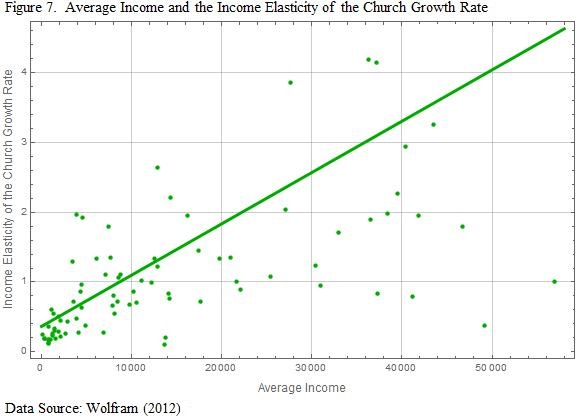
The elasticity of Church growth to a change in fertility is positive. An increase in fertility accelerates growth of the Church, a decrease slows it. The relationship between fertility and the fertility elasticity is shown in Figure 8. Each point represents the fertility and the fertility elasticity combination of a country. The line is plotted through the points. It demonstrates that countries with low fertility rates experience the largest declines in Church growth in response to a drop in fertility. Low fertility countries tend to be high income countries. The fertility elasticity of Church retention, on the other hand, is not positive but negative. An increase in fertility is associated with decreased retention.

Are Inclusive Institutions Associated with Increased Secularism?
To answer the third question I used the July 27, 2012 WIN- Gallup International survey, “Global Index of Religiosity and Atheism” which identified three types of secular belief: people not interested in religion (sometimes called the “nones”), agnostics, and atheists. The survey also compared the change in the level of atheism in 57 countries. I used data from the survey to construct three variables: the percentage of nones, the percentage of atheists, and growth in atheists. My data on Church growth covered 36 countries for nones and atheists and 27 countries for growth in atheism. My methodology is the same. I model the level of growth in irreligiousness using two-stage least squares to measure the possible influence of institutions on the three measures of the irreligious by country, working through income and median age.
My results suggest that average income explains much of the difference in the percentage of nones and atheists between countries, but not the growth in atheists. Average income is positively related to percentage of nones and atheists. As average income increases, irreligious beliefs in the form of disinterest or atheism increase. Perhaps the disinterest in religion expressed by the nones is caused by comfort. They are simply not interested in change. Joining the Church, an organization that asks members to tithe, abstain from alcohol and sex outside of marriage just to start, would be disruptive.
Comparing the results of the previous regressions on Church growth to those on the irreligious is illuminating. First, estimated average income works is significantly and negatively associated with LDS Church growth, but is not sigificantly associated with the growth in atheists. Second, fertility may help to explain Church growth, but not the growth in atheists. Finally, in an unreported regression, I found that neither average income nor fertility is significantly associated with the number of members by country, but income and fertility were significantly associated with the level of nones and atheists in a country. Variables that predict Church growth also predict the levels of the irreligious.
Does Secularism Affect Church Growth?
I find that the growth in atheism does not significantly affect Church growth. Apparently, they are two independent events. Conversely, both the percentage of nones and atheists in a country do affect the growth of the Church. The responsiveness of Church growth to a change in the percentage of nones in a country as measured by secularism elasticity depended strongly on the level of nones within the country. The average nones elasticity of all countries is -2.77, implying that a 1 percent higher level of secularism would be associated with a fall in Church growth by 2.77 percent, making Church growth less responsive to it than a change in fertility, but more responsive to it than a change in average income. In Canada, where 40 percent of the population describes themselves as nones, a 1 percent increase in the percentage of nones would be associated with a 3.51 decline in Church growth. In Poland, where only 9 percent of the population describes itself as nones, a 1 percent increase in the percentage of nones would be associated with only a .29 decline in Church growth. With the quality of estimates using variables related to retention in mind, the average nones elasticity of retention is 9.91.
The percentage of atheists in a country has a similar relationship as the percentage of nones. The average elasticity for all countries was -3.6, implying that a 1 percent increase in the percentage of atheists would be associated with a 3.61 percent decline in the growth of the Church. The elasticity of Church growth to the percentage of atheists depended greatly on the level of atheism. In France, where 29 percent of the population describes itself as atheists, a 1 percent increase in atheists would be associated with an 8.02 percent decrease in Church growth. Only 3 percent of Colombians describe themselves as atheists. In Colombia, a 1 percent increase in atheists would be associated with only a .52 percent decline in Church growth. The percentage of atheists in a country has the opposite relationship to retention. The average atheist elasticity of retention is 10.97. There are at least two explanations as to why higher levels of secularism would cause Church growth to fall and retention to increase. Secularism may not be causal but a current trend. Good institutions cause high income which causes secularism to rise, Church growth to fall but retention to rise. An alternative explanation is that secularism does have a causal relationship with growth in that an individual leading a secular lifestyle may be harder to convert, but this is not causally related to retention.
Conclusions and Recommendations for Future Research
Early political and economic institutions laid the foundation for current institutions that govern the affairs of men and establish the conditions under which the LDS Church operates in the countries of the world. Inclusive institutions tend to disperse political and economic power, protect innovative ideas and organizations, and generate broad levels of wealth and high per capita income while suppressing fertility rates. Church membership grows slowly under these conditions. Extractive institutions concentrate political and economic power in the hands of elites who are wary of new ideas and innovation. Extractive institutions are associated with poverty, low income and high relative fertility rates. Church membership tends to grow rapidly. The empirical results on growth fit the secularization hypothesis that states that people grow less religious as a country grows wealthier. This knowledge is disconcerting because members hope that their family, friends and brothers and sisters in the gospel can simultaneously progress economically as well as spiritually.
The silver lining behind the gray cloud of the secularism hypothesis is that the same inclusive institutions that increase secularism increase retention of members within the Church. The gray cloud behind the silver lining of fast growth in countries with extractive institutions is late access to membership in the Church, and low retention of members. Church membership is greater in countries with inclusive institutions because the Church was first able to proselytize there (early access) and retention rates are higher. The United States is the home to 42 percent of all LDS Church members. The United Kingdom, Australia, Canada, New Zealand and Japan each have more than 100,000 members. If addiitonal international measures of retention like Sacrament Meeting attendance or the percentage of men holding the priesthood were available, the strength of the Church in countries with inclusive institutions would no doubt be more evident.
Living in a country with extractive institutions presents challenges to citizens, and many are passed on to the Church. Government programs benefit the ruling elite, by design a small segment of the population, and limit opportunities for others as a consequence; most people are poor. Poverty may humble people in preparation to receiving the gospel but it can also distract from spiritual growth. Whether lifelong members or converts, the poor have little to invest in human capital, and high fertility rates spread these resources over more children. The pool of Church leadership will be shallow compared to countries with inclusive institutions. New converts will have difficulty understanding the role of a lay leadership, and the qualified leadership that exists will be overburdened. Retention is lower and Church programs underfunded. Perhaps the problem of retention is most severe for young, single members. Low retention may signify that local congregations cannot achieve or sustain the critical mass needed to prepare youth to serve missions and find marriage partners. Young members seeking marriage may be driven from the Church for lack of potential partners.
Inclusive institutions protect individual freedoms including freedom of religion and freedom from religion. The Church must compete in a more crowded spiritual arena. Inclusive economic institutions promote innovation that builds income and wealth for large segments of society. While wealth gives access to goods and services that are substitutes for programs of the Church, it also means that members can generously fund Church programs.
However, total fertility rates are low in countries with inclusive institutions. In high income countries, children cost more in terms of goods and income that must be committed to raise a child. Adverse unexpected events such as the death of a child also decline. Women choose to have fewer children. These economic conditions sway women in the Church as well. Heaton and Goodman (1985) find that while the total fertility rate of members in the United States remains above the national average, that rate has been falling. In countries with inclusive institutions, educational attainment by women is associated with lower fertility, but less so for Mormon women in the United States, Chile and Brazil (Fox and Heaton 2012); in Japan and Great Britain, a Mormon woman’s education is associated with greater fertility (Heaton 1998). These facts suggest that fertility rates will slow but remain sufficiently high to contribute to the growth of the Church.
The combination of high income and low fertility increases the odds that investment in education and other forms of human capital will be profitable. Members are prepared for leadership positions within the Church and the preparation is broad and deep. Parents invest freely to develop the human capital of their children and missionaries are better prepared for service. That there is a direct relationship between human capital and service in the Church is more than supposition. Smith (2012), in a Pew survey, reports evidence that suggests a link between retention and human capital. Ninety percent of college graduates who are members of the Church report that religion is very important in their lives while 70 per cent with a high school education or less report the same. Becker, Glaeser and Murphy (1999) provide a caution to this rosy picture, however. Very low rates of fertility could cause population to fall and that circumstance could significantly reduce incentives to invest in human capital. Finally, low fertility rates within the Church may cause a problem in countries with low retention. The number of youth and single young adults may be insufficient to create faith building programs or allow broad-based dating for single young adults seeking marriage partners.
Nevertheless, members in countries with inclusive institutions can be a boon to members in countries with extractive institutions. Members in countries with inclusive institutions are blessed with the opportunity to subsidize members in poor countries with missionaries and money to fund their programs and members in poor countries are blessed with those gifts which they can accept and enlarge.
The Church itself is an inclusive institution. Wealthy members subsidize the poor as members in high income countries subsidize the operation of units in low income countries, funding the construction of temples and meeting houses, printed and visual materials and a formidable missionary force, well trained and educated.
Stepping back, however, there are pitfalls, as well. Nephite history describes a pattern of societal behavior called the pride cycle. A humble people is blessed with prosperity. Prosperity turns to pride and then wickedness. Finally, the wicked are humbled. Something akin to the Nephite pride cycle may be occurring over a larger, more global scope. Western countries with inclusive political and economic institutions experienced high and consistent economic growth, but its citizens, blessed with wealth, are becoming more secular, turning from God. Church membership growth is only inching forward. Countries with extractive institutions are poor and young, but they are experiencing significant membership growth. Missionaries have little difficulty finding people to teach and baptizing them. Here the similarities to the Nephites end. Members in countries with inclusive institutions have higher retention rates than those in countries with extractive institutions. Remember that the secular are largely abandoning traditional Christian denominations that offer substitutes for the gospel of Jesus Christ, many of the same denominations which God the Father and His Son, Jesus Christ instructed Joseph Smith not to join. Higher rates of retention in the LDS Church in secularizing countries may not be so inexplicable after all.
The data does show that inclusive institutions are associated with more people choosing secular lifestyles and that it dramatically dampens Church growth but that a generalized context of freedom (freedom from want and freedom to choose) also results in higher levels of retention. The data also fail to demonstrate or even suggest which socioeconomic demographics are selecting secular lifestyles. The data is a snapshot in time. It does not indicate if more people will choose secularism as countries gain wealth or if wealthy countries always have higher but relatively stable levels of secularism subject to cyclical moves.
The general LDS leadership is aware of the challenges to the Church brought by high income, falling fertility rates and secularism, and will no doubt modify the way the gospel is delivered to reach people in wealthy, aging countries. Indeed, the process is well underway. Lowering the age of missionary service will produce more missionaries and probably improve retention of members born into the Church. Placing materials online on Church sponsored sites explaining controversial subjects such as race and the priesthood or the method of translation of the Book of Mormon, will increase the knowledge of members and reduce or eliminate the shock of encountering the information on unfriendly sites. Encouraging retired couples to serve missions might appeal to older demographics in wealthy countries. Use of electronic media might allow access to people who are inaccessible by traditional missionary methods. Materials and teaching methods might be developed to appeal to people who are comfortable and do not feel a need to change. Organizing young single adult wards gives young members more opportunities to find marriage partners.
In addition to the programs it now offers, the Church might further develop programs that would allow Church members from low income countries with extractive institutions to serve missions. Such programs might create a moral hazard in that a young man or woman might find missionary service more lucrative than the job market, but such moral hazards have been encountered and dealt with in the past, as when the quota system used during the Korean and Vietnam Wars gave young men incentive to serve as missionaries when they might not have otherwise. The Perpetual Education Fund and the Pathways program can lift members out of poverty in countries with extractive resources. Perhaps these programs could be given more emphasis. The Church might explore programs to help youth and young single adult members associate with, then date and marry other members in areas where membership is widely dispersed. Perhaps youth programs could be run combining wards and branches rather than attempting to organize a program in each unit. Social media might be used to help returned missionaries connect with members of the opposite sex whom they met on their missions but could not date.
Growth of the Church has never been easy, and it won’t be in the future, for there must be “an opposition in all things” (2 Nephi 2:12). Viewing Church growth through the lens of inclusive versus extractive institutions gives us tools to facilitate growth in widely disparate societies.
References
Acemoglu, Daron, and James A. Robinson. Why Nations Fail: The Origins of Power, Prosperity, and Poverty. New York: Crown Publishers, 2012.
Acemoglu, Daron, Simon Johnson, and James A. Robinson. “The Colonial Origins of Comparative Development: An Empirical Investigation.” The American Economic Review 91, no. 5 (2001): 1369-1401.
Acemoglu, Daron, Simon Johnson, and James A. Robinson. “Reversal of Fortune: Geography and Institutions in the Making of the Modern World Income Distribution.” The Quarterly Journal of Economics 117, no. 4 (2002): 1231-1294.
Acemoglu, Daron, Simon Johnson, and James Robinson. “The Rise of Europe: Atlantic Trade, Institutional Change, and Economic Growth.” The American Economic Review 95, no. 3 (2005): 546-579.
Barro, Robert J., and Rachel M. McCleary. “Religion and Economic Growth.” American Sociological Review 68, no. 5 (2003): 760-781.
Becker, Gary S. “An Economic Analysis of Fertility.” in Demographic and Economic Change in Developed Countries, ed. Universities- National Bureau, 209-40. New York: Columbia University Press, 1960. http://www.nber.org/chapters/c2387.pdf.
Becker, Gary S., Edward L. Glaeser, and Kevin M. Murphy. “Population and Economic Growth.” American Economic Review 89, no. 2 (1999): 145-149.
Becker, Gary S., Kevin M. Murphy, and Robert Tamura. (1990). “Human Capital, Fertility, and Economic Growth.” Journal of Political Economy 98, no. 5 (1990): 12-37.
Church Almanac. Salt Lake City: Desert News. Published Annually.
Dew, Sheri. Go Forward with Faith: The Biography of Gordon B. Hinckley. Salt Lake City: Deseret Book Co., 1996
Dreher, Rod, “Sex after Christianity.” The American Conservative, April 11, 2013. http://www.theamericanconservative.com/articles/sex-after-christianity.
European Commission. Total Fertility Rate, 1960-2011 (live births per woman). Last modified January 29, 2013. Accessed February 6, 2014. http://epp.eurostat.ec.europa.eu/statistics_explained/index.php?title=File:Total_fertility_rate,_1960-2011_%28live_births_per_woman%29.png&filetimestamp=20130129121040.
Fox, Kiira, and Tim B. Heaton. “Mormon Fertility in Latin America.” Review of Religious Research 55 (2012): 275-296.
Fukuyama, Francis. The Origins of Political Order: From Prehuman Times to the French Revolution, New York: Farrar, Straus and Giroux, 2011.
Funk, Cary, and GregSmith. “Nones” on the Rise: One-in-Five Adults Have No Religious Affiliation. Washington, D.C.: Pew Forum on Religion & Public Life, 2011. http://www.pewforum.org/files/2012/10/NonesOnTheRise-full.pdf
Hart, David Bentley. Atheist Delusions: The Christian Revolution and Its Fashionable Enemies, New Haven & London, Yale University Press, 2009.
Heaton, Tim B. “Religious Influences on Mormon Fertility: Cross National Comparisons,” in Social Research on the LDS Church and its Members, ed. James T. Duke. Provo, UT: Religious Studies Center, Brigham Young University, 1998. http://rsc.byu.edu/archived/latter-day-saint-social-life-social-research-lds-church-and-its-members/14-religious.
Heaton, Tim B. “Vital Statistics,” in Latter-day Saint Social Life: Social Research on the LDS Church and its Members: Provo, UT: Religious Studies Center, Brigham Young University, 1998. 105–132. https://rsc.byu.edu/archived/latter-day-saint-social-life-social-research-lds-church-and-its-members/4-vital-statistics.
Heaton, Tim B., and Kristen L. Goodman. “Religion and Family Formation.” Review of Religious Research 26, no. 4 (1985): 343-359.
Horowitz, Juliana Menasce. The Global Divide on Homosexuality. Washington, D.C.: Pew Forum on Religion & Public Life, 2013. http://www.pewglobal.org/2013/06/04/the-global-divide-on-homosexuality/
Hudson, Valerie M., and Andrea M. den Boer. Bare Branches: The Security Implications of Asia’s Surplus Male Population. Cambridge, London: The MIT Press, 2012.
Keysar, Ariela. “Who Are America’s Atheists and Agnostics?” in Secularism & Secularity: Contemporary International Perspectives, eds. Barry A. Kosmin and Ariela Keysar. Hartford, CT: Institute for the Study of Secularism in Society and Culture, 2007. http://www.scribd.com/doc/17142803/Secularism-Secularity-Contemporary-International-Perspectives
Last, Jonathan V. What to Expect When No One’s Expecting. New York: Encounter Books, 2013.
Monson, Thomas S. “Dare to Stand Alone.” Ensign, November 2011. https://www.lds.org/general-conference/2011/10/dare-to-stand-alone?lang=eng#1-PD50029123_000_3060.
“Newsroom: The Official Resource for News Media, Opinion Leaders and the Public,” The Church of Jesus Christ of Latter-day Saints, accessed April 18, 2014, http://www.mormonnewsroom.org/.
Oaks, Dallin H. “No Other Gods.” Ensign, November 2013. https://www.lds.org/general-conference/2013/10/no-other-gods?lang=eng.
Perry, L. Tom. “Obedience to Law is Liberty.” Ensign, May 2013. https://www.lds.org/general-conference/2013/04/obedience-to-law-is-liberty?lang=eng.
Putman, Robert D., and David E. Campbell. American Grace. New York, London, Toronto, Sydney: Simon & Schuster, 2010.
Seminaries and Institutes of Religion Annual Report for 2013, The Church of Jesus Christ of Latter-day Saints. http://www.mormonnewsroom.org/files/Seminaries-and-Institutes-2013-Annual-Report/2013-annual_report_seminaries_institutes.pdf.
Smith, Adam. An Inquiry into the Nature and Causes of the Wealth of Nations. Edited by Edwin Cannan. London: Methuen & Co., Ltd., 1904. http://www.econlib.org/library/Smith/smWN.html.
Smith, Gregory. Mormons in America: Certain in Their Beliefs, Uncertain of Their Place in Society. Washington, D.C.: Pew Forum on Religion & Public Life, 2012. http://www.pewforum.org/files/2012/01/Mormons-in-America.pdf.
WIN-Gallup International survey, Global Index of Religiosity and Atheism, 2012. http://www.wingia.com/web/files/news/14/file/14.pdf.
Wolfram Research, Inc. Mathematica, Version 9.0., Country Data function, Wolfram Research, Inc., Champaign, 2012.
Appendix A

I borrow theory, data and econometric methodology from Acemoglu, Johnson and Robinson (2001). In an effort to find a causal link between institutions, income, fertility and secularism, I submit the following causal chain: Mortality of European settlers influences current institutions which influence average income. Average income influences fertility; along a separate path, it also influences secularism. Both fertility and secularism influence Church growth and a component of growth, the retention of members. Growth is measured as the percentage change in membership by country between 2012 and 2011. Because the Church does not publish systematic statistics on retention of members, it was necessary to create a plausible estimate. I used data on Seminary enrollment provided by the “Seminaries and Institutes of Religion Annual Report for 2013” and demographic data provided by Mathematica’s CountryData function to estimate activity rates for seminary students by country (see Table A1 for a more detailed description). The seminary attendance rates are similar to but generally higher than the Sacrament Meeting attendance rates reported by Heaton (1998). [4]
The influence of the social variables on Church growth and retention of members is measured through two-stage least squares regression analysis which produces coefficients that measure the relationship between them and the Church variables and test their statistical significance. Because the methodology is well known I provide a bare bones description. I propose falsifiable hypotheses to test if Church variables are in part determined by current economic and political institutions as is average income, secularism and fertility. A simple ordinary least squares (OLS) framework measuring Church variables using any two of the economic and social variables is biased because all the potential right-hand side variables are related through the omitted underlying variable, mortality of European settlers. A two-stage least squares regression resolves the problem by using an instrumental variable to estimate another variable, the predictor variable, and uses the estimates in the second-stage regression to estimate final variable. I use this method to answer four hypotheses presented as questions in the “Results of Statistical Testing” section of the paper. For an instrumental variable to be effective it cannot affect today’s outcomes expect through the suggested path. The mortality rate of European settlers is a good candidate as an instrument. It was used successfully by Acemoglu, Johnson and Robinson and it is unlikely to impact today’s economic performance or Church growth, except through the institutions established by colonizers.
The first question is, does the mortality rate of European colonizers which influenced institutional development affect Church growth? It is useful to compare my results to Acemoglu, Johnson and Robinson’s (2001). It is necessary because I do not have an alternative variable that describes early institutions over more countries. I am limited to the mortality rate of European settlers as a proxy for early institutions both by desirability and necessity. In the first-stage, I use the mortality rate of European settlers in 45 colonies, the same variable used by Acemoglu, Johnson and Robinson (2001) as an instrumental variable to estimate the predictor variables current institutions, average income and the total fertility rate. A full description of data and sources is presented in Table A1, given at the beginning of this appendix.
Because I am using only 45 of Acemoglu, Johnson and Robinson’s 64 observations, I compared the results using the 45 observations to those of full sample using the two stage analysis with the mortality rate as an instrument for average protection against expropriation (institutions), the independent variable of the second stage used to explain variation in income today. I estimate the coefficient that measures the influence of mortality on average income, the natural log of per capita gross domestic product measured at purchasing power parity, at -.767 with a t-test of -5.10. Their estimate was equal to -.61 with a t-test of -4.69. The unreported second-stage was similar as well. I estimate the coefficient for institutions at .83 with a t-test of 5.90 compared to Acemoglu, Johnson and Robinson’s coefficient of .94 with a t-test of 5.86. Reducing the sample size did not dramatically alter the coefficient or its statistical significance. Table A2 reports the results of the first and second-stage regressions on the variable Church growth. All variables in both stages are significant at the 1 percent level and all have the anticipated sign. [5]
The mortality rate of European colonizers influences Church growth and the retention of members today. I believe that the lack of statistical significance is a result of the inexact measurement of retention rather than a weakness in the institutional theory.

The Table A3 results are not only useful as a comparison to the Table A2 results, they also answer the second question: Do modern political and economic institutions affect Church growth? All coefficients for growth estimates are significant at the 1 percent level and all have the correct sign; the coefficients for the retention estimates are significant at the 5 percent level. Current institutions explain part of the distribution of average income and fertility (first–stage) throughout the world, and these variables explain a portion of Church growth and the retention of members. More inclusive institutions are associated with an increase in average income, and higher income lowers growth while improving retention; lower fertility are associated with a slowing in growth to slow but rising retention.
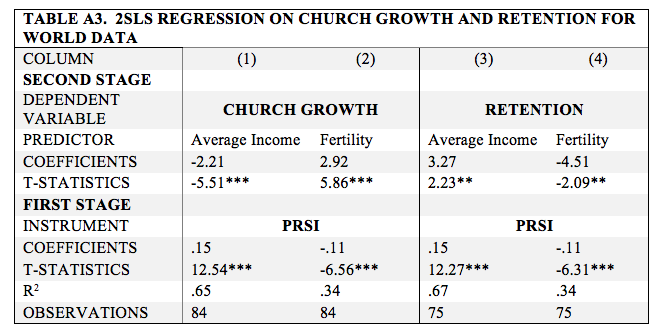
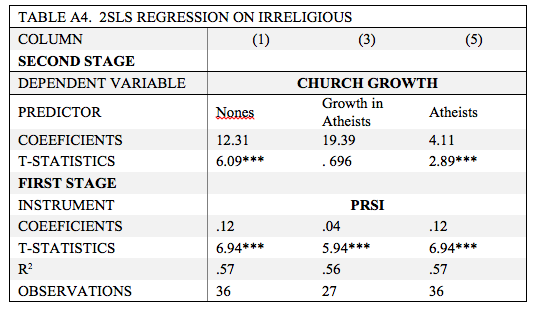
The fourth and final question asks if the secularism affects the growth of the Church and the retention of its members. I began with a check on the Table A5 (growth) and A6 (retention) regressions by comparing the results of 2SLS to those of Table A3 for regressions using Church growth and retention as the dependent variable, average income or fertility as predictors and institutions as the instrumental variable. All variables using church growth, for except the growth in atheists, have the correct sign and are significant at the 1 percent level. Growth in atheists is not statistically related to growth. The results using retention of members are more varied. Like the variable growth, retention is not statistically related to the growth in atheists. Retention is weakly related to average income and the percentage of irreligious (nones). Although the relationship between fertility and retention is not statistically significant, it is close enough that when combined with the results with the worldwide data set to strengthen the argument that retention increases as fertility falls.
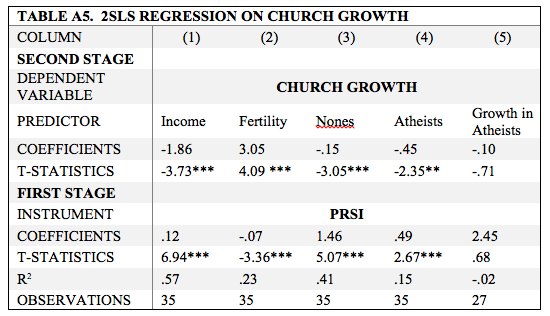
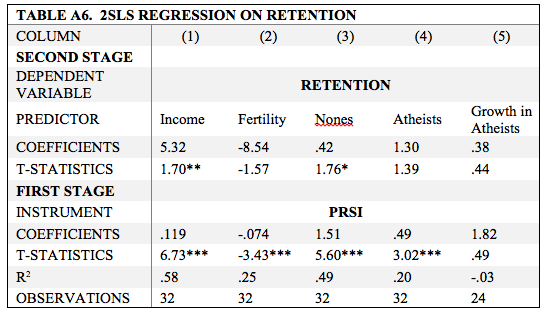
NOTES:
[1] Secularism is defined as “indifference to or rejection or exclusion of religion and religious considerations.” The word is used to describe two distinct ideas in this paper. First, individuals sometimes adopt secularism as a lifestyle. Second, governments practice secularism; officials are appointed without approval of religious organizations. The first usage is consistent with Elder Perry’s talk. Secularism in countries with inclusive institutions offers both benefits and costs to the Church. Merrian-Webster Online, s.v. “secularism,” accessed February 6, 2014, http://www.merriam-webster.com/dictionary/secularism. [Back to manuscript].
[2] I report only results in this section. For a full description of the statistical methodology refer to Appendix A; relationships between variables are significant at the 1 percent level are referred to as significant. Relationships that are significant at the 5 or 10 percent levels are referred to as weakly significant. [Back to manuscript].
[3] Retention is measured using an estimate of the percentage of Seminary age members who attend Seminary by country. For details see the statistical report in Appendix A. [Back to manuscript].
[4] Heaton’s Sacrament Meeting rates are reported first and my estimated rates provided in parentheses; they are: Africa—35 percent (39.8 Percent), Asia—25 percent (32.8 percent), Canada—40-50 percent (51.9 percent), Europe—35 percent (41.8 percent), Latin America—25 percent (23.6 percent), the South Pacific—40 to 50 percent (34.8 percent), South American 25 percent (26.0 percent), and the United States—40-50 percent (56.6 percent). [Back to manuscript].
[5] Two-stage estimates using retention as the dependent variable were not statistically related to mortality through institutions, average income or fertility. I believe that the lack of statistical significance is a result of the inexact measurement of retention rather than a weakness in the institutional theory. [Back to manuscript].
![]()
Full Citation for this Article: Wilson, Brooks (2014) "Institutions and LDS Church Growth," SquareTwo, Vol. 7 No. 1 (Spring 2014), http://squaretwo.org/Sq2ArticleWilsonInstitutionalGrowth.html, accessed <give access date>.
![]() Would you like to comment on this article? Thoughtful, faithful comments of at least 200 words are welcome. Please submit to SquareTwo.
Would you like to comment on this article? Thoughtful, faithful comments of at least 200 words are welcome. Please submit to SquareTwo.